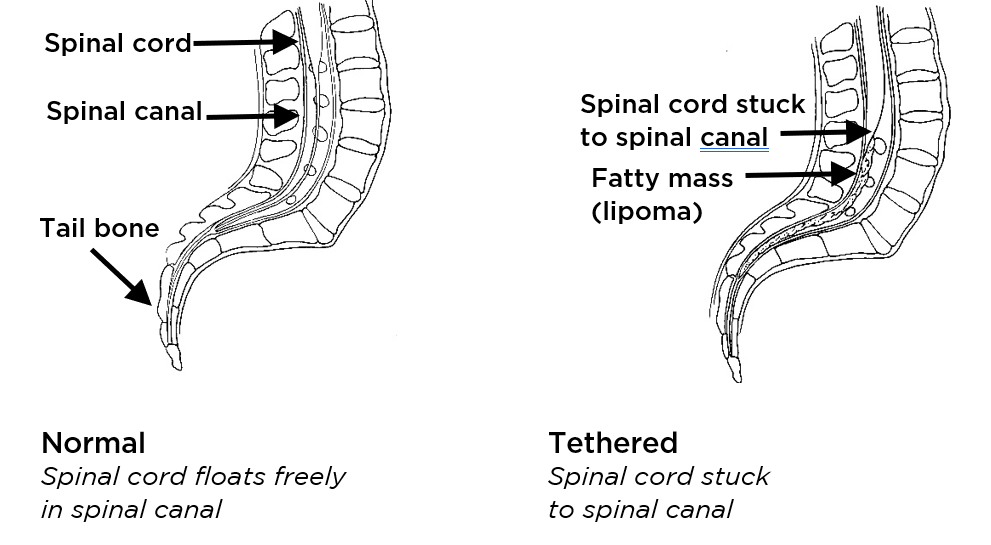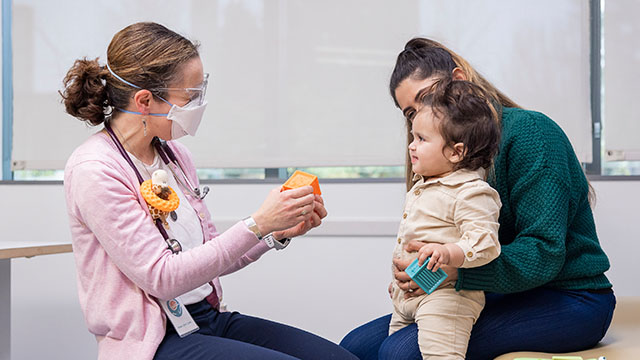Tethered Spinal Cord
Contact the Neurosciences Center
What is a tethered spinal cord?
Normally, the spinal cord floats freely inside a tube in the spine called the spinal canal. A tethered spinal cord is pulled down and stuck to the inside of the spinal canal.
As a child grows, a tethered spinal cord will stretch like a rubber band. If the problem is not treated, it can cause lasting damage to a child’s spinal nerves. This can lead to loss of function, like the ability to walk or control their bladder.
Tethered spinal cord most often happens in children who are born with problems affecting the spinal cord, such as:
- A small sac sticks through an opening in the spine (myelomeningocele). This is the most serious form of spina bifida.
- A fatty mass is attached to the spinal cord (lipomyelomeningocele).
- The very end of their spinal cord is held down too tightly because the flexible fiber connecting it to the bottom bones of the spine is thicker than normal (fatty filum).
In a child born with such a condition, their spinal cord may become stuck, or tethered, to the fatty filum, myelomeningocele or lipomyelomeningocele. This pulls on the spinal cord as the child grows, causing symptoms.
A child also may have a tethered spinal cord because:
- They have a small abnormal channel from their skin into their spinal canal (dermal sinus tract)
- Their spinal cord is split into 2 cords near the end (diastematomyelia)

Neurosciences Care at Seattle Children's
What are the symptoms of a tethered spinal cord?
Children with a tethered spinal cord may have:
- Back pain or shooting pain in the legs
- Weakness, numbness or problems with how leg muscles work
- Tremors or spasms in the leg muscles
- Changes in the way the feet look, like higher arches or curled toes
- Loss of bladder or bowel control that gets worse
- Abnormal curve of the spine (scoliosis) that changes or gets worse
- Repeated bladder infections
- A fatty mass, dimple, birthmark or tuft of hair on the back
- Anorectal malformations
How is tethered spinal cord diagnosed?
We bring together experts in Neurology, Neurosurgery, Urology and Neurodevelopmental to diagnose your child. Our doctors:
- Examine your child, looking for signs and symptoms
- Use MRI (magnetic resonance imaging) to take high-quality pictures inside your child's body to help us assess your child's condition
How is a tethered spinal cord treated?
If your child is diagnosed with a tethered spinal cord, surgery is needed to free the cord.
As they operate, our neurosurgeons use advanced neuromonitoring to avoid the risk of further damage to your child’s nerves.
First the neurosurgeons remove part of 1 or more of the bones in your child’s spine (a laminectomy). This lets them reach the spinal cord, the spinal nerve roots and the sac that protects the spinal cord (thecal sac).
Under the operative microscope, the neurosurgeons open up the thecal sac and use a laser to release the spinal cord from the fat or scar tissue. The laser is more precise than other cutting tools and leads to less bleeding and scarring.
After the spinal cord is free, neurosurgeons sometimes apply a patch to the covering of the spinal cord. This limits the chances cerebrospinal fluid (CSF) will leak.
There is a chance the cord will attach again as your child grows. Some children need more surgeries. This is more likely in children who have a myelomeningocele (the most serious form of spina bifida) or lipomyelomeningocele.
Read about Laminectomy: Care after Surgery (PDF) (Spanish) (Russian) (Vietnamese)
Why choose Seattle Children's for tethered spinal cord treatment?
- Your child will be in the hands of experts. Our neurosurgeons have a lot of experience treating children with tethered spinal cords and related conditions.
- Seattle Children’s neurosurgery team is among the most experienced in the nation and the most experienced by far in the Pacific Northwest. Each week, we perform surgery to correct a tethered spinal cord.
- In many cases, a plastic surgeon partners with a neurosurgeon for the best possible outcome.
- As they operate, our neurosurgeons use a laser for increased precision. This results in less bleeding and scarring.
- If your baby requires special intensive care, our Level IV Neonatal Intensive Care Unit (NICU) team is skilled and equipped to care for the sickest newborns.
- We have the expertise to treat other complex problems that may affect children with tethered spinal cords, such as myelomeningocele or lipomyelomeningocele. We bring together experts in Neurology, Neurosurgery, Neurodevelopment and Urology.
Contact Us
If you would like an appointment, ask your child’s primary care provider for a referral. If you have a referral, call 206-987-2016 to make an appointment.
Providers, see how to refer a patient.
If you have questions, contact us at 206-987-2016 or 844-935-3467 (toll free).
Paying for Care
Learn about paying for care at Seattle Children’s, including insurance coverage, billing and financial assistance.


